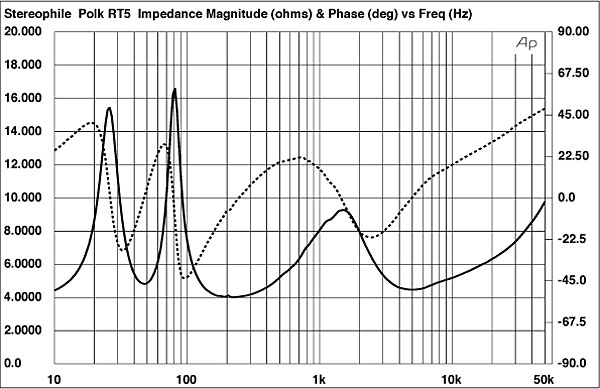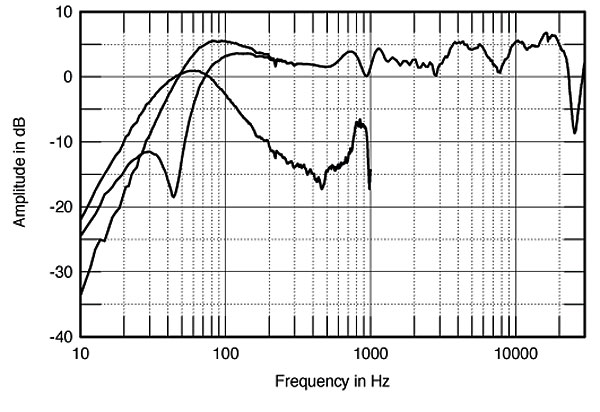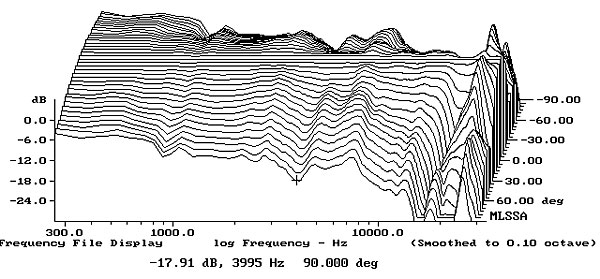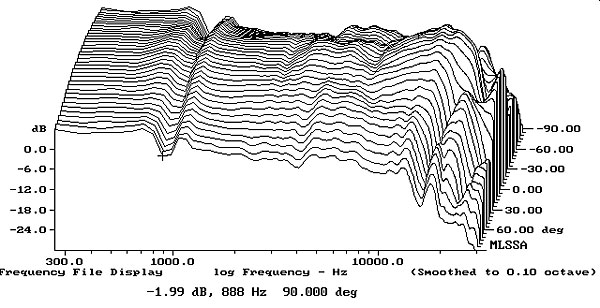| Columns Retired Columns & Blogs |
Interesting review Wes . And it's nice to hear Larry A is still around and active in audio . It makes my day to hear such things . Regards Tim
The little Polk was surprisingly sensitive, my measurements giving an estimated B-weighted figure of 91dB/2.83V/m. However, its impedance plot (fig.1) revealed that the speaker lingered around the 4 ohm mark in the midrange and high treble. The small "blip" just above 200Hz in the solid magnitude curve indicates the presence of some sort of resonance at that frequency, while the "saddle" in the same trace at 47Hz reveals the tuning of the twin reflex ports. Its high sensitivity and the overall even nature of its impedance curve will make the Polk a good candidate for single-ended triode amplification, as WP found.

Fig.1 Polk RT5, electrical impedance (solid) and phase (dashed) (2 ohms/vertical div.).
Fig.2 shows the RT5's anechoic response, averaged across a 30° horizontal window on the tweeter axis and spliced to the nearfield responses of the woofer, the sum of the two ports, and the complex sum (amplitude and phase) of all three. The minimum in the woofer's output can be seen at 43Hz, while the port output peaks just a little bit higher than this. A slight peak in the port output can be seen between 800Hz and 900Hz, coincident with a suckout in the speaker's on-axis output at the same frequency. The bass is bumped up a little, as might be expected from WP's auditioning notes, but the payoff is good low-frequency extension: –6dB at 38Hz ref. the level at 300Hz, which is quite impressive for a speaker of this size. Higher in frequency, the response trend is quite well balanced for an inexpensive speaker. The mid- and high trebles are both a little hot on-axis, which I found surprising considering that WP thought the speaker lacked HF sparkle—which I also noted in my own auditioning in his room.

Fig.2 Polk RT5 anechoic response on tweeter axis at 50", averaged across 30° horizontal window and corrected for microphone response, with the nearfield woofer and port responses and their complex sum plotted below 300Hz, 1kHz, and 300Hz, respectively.
The reason for such a disparity between axial response and perceived balance is often to be found in a speaker's dispersion. Fig.3, for example, shows the changes in the Polk RT5's response to its sides, which means that the on-axis response looks like a straight line. The speaker does roll off a little early to the side in the top two octaves, but note the very even spacing of the contour lines in this graph, something that correlates with well-defined stereo imaging. For interest's sake, fig.4 shows the actual responses measured to the speaker's sides: the suckout between 800Hz and 1kHz is evident on every axis. Perhaps it is this slight absence of upper-midrange energy that makes the RT5 sound rather dark.

Fig.3 Polk RT5, horizontal response family at 50", normalized to response on tweeter axis, from back to front: differences in response 90°–5° off-axis; reference response; differences in response 5°–90° off-axis.

Fig.4 Polk RT5, horizontal response family at 50", from back to front: response 90°–5° off-axis; response on tweeter axis; response 5°–90° off-axis.
Wes found that short stands worked better than high stands with the RT5. The speaker's plot of vertical dispersion (fig.5; again, just the changes are shown) reveals that a large suckout in the crossover region develops below the tweeter axis, shown by the cursor position at 2.9kHz. It's best to sit so that your ears are on or just above the level of the Polk's tweeter.

Fig.5 Polk RT5, vertical response family at 50", normalized to response on tweeter axis, from back to front: differences in response 45°–5° above-axis; reference response; differences in response 5°$45° below-axis.
In the time domain, the RT5's step response (fig.6) indicates that the woofer and tweeter are connected with the same positive acoustic polarity. The associated cumulative spectral-decay plot (fig.7) is very clean throughout the treble, with only a small ridge of delayed energy apparent at 3kHz, and something happening at the frequency of the on-axis suckout.

Fig.6 Polk RT5, step response on tweeter axis at 50" (5ms time window, 30kHz bandwidth).

Fig.7 Polk RT5, cumulative spectral-decay plot at 50" (0.15ms risetime).
Examining the Polk's panel behavior with a simple plastic-tape accelerometer revealed the presence of a reasonably strong resonant mode at 230Hz, coincident with the "blip" in the speaker's impedance curve. This was apparent on all surfaces, but strongest on the rear panel (fig.8)—fortunately, this faces away from the listener.—John Atkinson

Fig.8 Polk RT5, cumulative spectral-decay plot of accelerometer output fastened to cabinet side. (MLS driving voltage to speaker, 7.55V; measurement bandwidth, 2kHz.)
